Assessing Oxidation Condition and Lubricant Refreshment in Turbine Oils
Turbines are critical pieces of equipment for power plants and related industries. Varnish formatio...
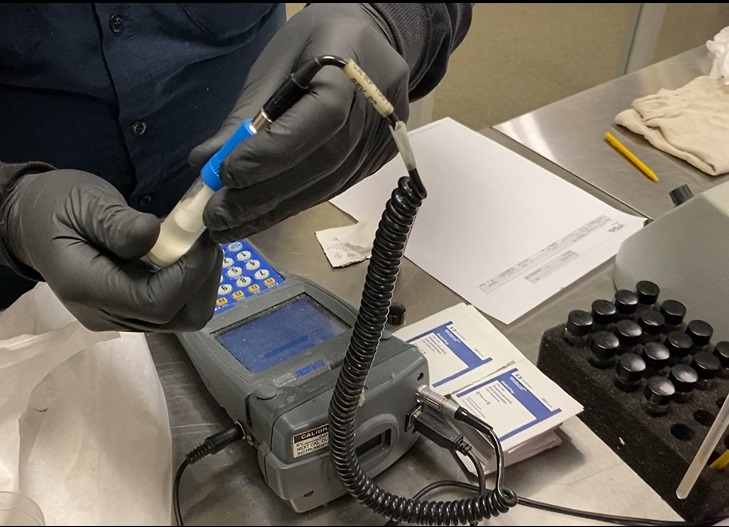
The Ruler (remaining useful life evaluation routine) is a modern and cost-effective method of evaluating the antioxidant reserve of a lubricant. It exhibits good correlation with Rotating Pressure-Vessel Oxidation Test (RPVOT), Fourier-Transform Infra-Red (FTIR), Base Number (BN), Kinematic Viscosity (KV) and Acid Number (AN) tests. The method was initially developed to measure the remaining useful life of gas turbine engine lubricants and has now been developed for a large range of lubricants and greases. Its ability to directly measure the relative remaining antioxidant concentration of a lubricant provides the lubricant user with vital information, which ultimately leads to substantial cost savings.
One of the most powerful benefits of the Ruler is its ability to allow lubricant users to make proactive decisions. Tests like Kinematic Viscosity (40°C & 100°C), Acid Number (TAN), Fourier-Transform Infra-Red (FTIR) oxidation and Base Number (BN) provide the user with information on the present nature of their lubricant. Significant changes in results are observed after the lubricant has already begun to degrade. Monitoring antioxidant depletion allows the user to establish normal rates and make decisions on when to expect the lubricant to degrade. Users can therefore make decisions on whether to change the lubricant or monitor its state more frequently until it is considered to be at the end of its useful life.
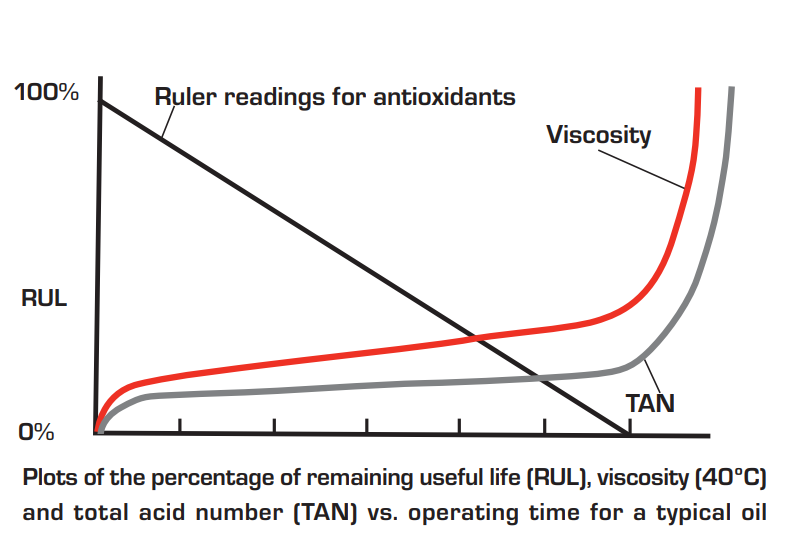
Figure - The chart illustrates the general response of the RULer compared to Acid Number (AN) and Kinematic Viscosity (KV) testing.
The Ruler device uses an electroanalytical method known as voltammetry in determining the relative antioxidant concentration of a lubricant. Voltammetry is based on the measurement of an electric current with respect to varying an applied voltage (potential). Its action can be illustrated as simply giving the test solution an "electric shock", with slowly increasing voltage until the antioxidants in the solution react. The "stronger" antioxidants will react only with a larger applied voltage compared to the "weaker" antioxidants. The Ruler therefore has the added ability of distinguishing between different antioxidants. The greater the reaction during the electric shock, the larger the amount of that particular antioxidant present.

Figure - The RULer instrument uses Linear-Sweep Voltammetry (LSV) to produce a voltammagram of the anti-oxidants present in the lubricant (courtesy of Fluitec).
The remaining useful life (RUL) of used oil is determined by measuring a new and used oil sample and comparing the peak areas on the voltammogram. The new oil is regarded as containing 100% antioxidants and the used oil is compared to this. If the peak area of the used oil is determined to be half the size of the peak area obtained for the new oil, it is regarded to have 50% RUL. Different percentages will be obtained for the different antioxidants present and the total %RUL will be the mean of these values. Different antioxidants may deplete at different rates.
This oil field facility is producing 17,000 barrels of oil per day, and is one of North America’s largest CO2 sequestering projects. The oil has been in service in this large centrifugal compressor for over 20,000 hours. The one anti-oxidant (phenolic) is almost completely consumed, however, the remaining anti-oxidant (aminic) is still in good concentration in the oil.
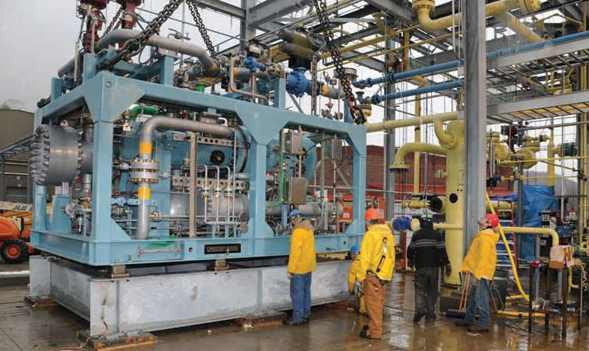
Figure - This large Dresser Datum Centrifigual Compressor is being utilized to sequester CO2 gas in one the largest projects of it`s kind in North America.
Additional testing including Rotating Pressure-Vessel Oxidation Testing (RPVOT) and Membrane Patch Colorimetry (MPC) for varnish potential indicate that the oil oxidative stae is stable and that no insolubles are forming in the oil that could lead to varnish. The analytical ferrogram also showed only nomimal component wear, and showed no visual signs of insoluble bodies (varnish precursors). As a result of the combined testing it was determined that no maintenance activities were warranted and that the compressor be resampled after 1,000 hrs operation to monitor this condition.
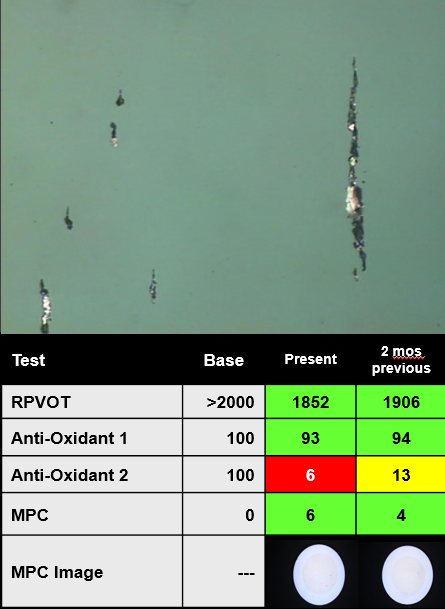
Figure - The RULer testing indicated a significant depletion of the phenolic anti-oxidant in the oil, however additional testing indicated that the oil was still in good operating condition.
WearCheck was contracted to provide Advanced Oil Monitoring (AOM) services for 4 Rolls-Royce aero-derivative gas turbines being commissioned in an aluminum mill to provide power to the plant. 100,000 litres of turbine oil was delivered to the plant and the four turbines were filled. The reliability technicians drew baseline samples from the four turbines and submitted the samples for AOM analysis. Surprisingly the RPVOT showed very little anti-oxidant present in all four systems. Additionally, Linear Sweep Voltammetry (RULer) testing showed very little phenolic anti-oxidant present in the oil. All other properties of the oil appeared normal. An early resample was suggested and the four turbines were resampled in two more months time. This time the analysis showed a critical concentration of phenolic anti-oxidants, and the MPC test for varnish showed a dramatic increase in insolubles present in the oil, which were also visually confirmed in the analytical ferrogram (top picture 200x magn).
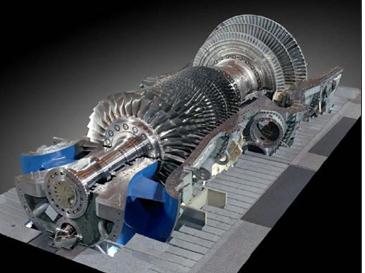
Figure - An aluminum mill commissioned four Rolls-Royce aero-derivative turbines and performed Advanced Oil Monitoring (AOM) at start-up and within two months of operation to monitor the oil and system condition.
It was suggested that the turbine oil had not been properly blended. One of the turbines was drained, flushed and re-filled with a new charge of turbine oil. Subsequent AOM testing showed that the anti-oxidants had been restored in the turbine, and that the new turbine oil had been properly formulated. As a result of taking action within a few months, the varnish did not being to accumluate in the turbine, and in fact the drain and flush was sufficient to remove the insolubles from the system.
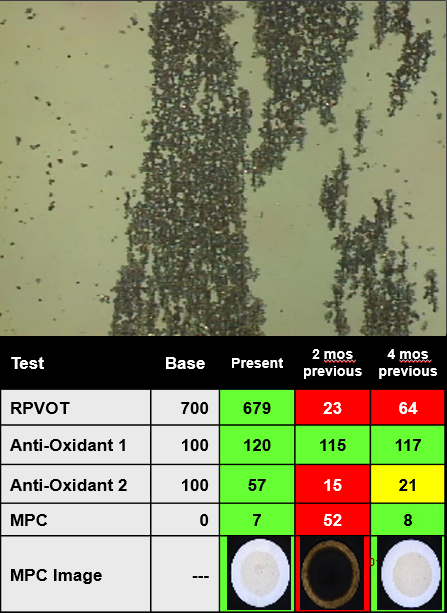
Figure - Unexpectedly the new turbine oil showed an issue with formulation, having only marginal amounts of phenolic anti-oxidant present, which rapidly led to the formation of insolubles in the turbine.